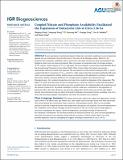Coupled nitrate and phosphate availability facilitated the expansion of eukaryotic life at circa 1.56 Ga
Abstract
Recent geochemical and paleontological studies have revealed a significant ocean oxygenation episode and an evolutionary leap of eukaryotes at the onset of the Mesoproterozoic. However, the potential role of nitrogen availability and its interaction with other nutrients in these environmental and biological events has not been investigated. Here we present an integrated study of nitrogen isotopes (δ15N), organic carbon isotopes (δ13Corg), and major and trace element concentrations from Member III of the Gaoyuzhuang Formation in the central North China Craton where the earliest macroscopic multicellular eukaryotic fossils were reported. The enrichments of redox‐sensitive elements (Mo, U, V), coupled with Mo‐U covariations, δ13Corg and I/(Ca+Mg), indicate that the Gaoyuzhuang Member III in the study area was deposited in largely suboxic‐anoxic environments with ephemeral occurrences of euxinia. These data reinforce previous inferences of a strongly redox stratified ocean during the early Mesoproterozoic, but a pulsed oxygenation event may result in deepening of the chemocline. The high δ15N values from the study section are interpreted as result of aerobic N cycling and the presence of a fairly stable nitrate pool in the surface oxic layer, possibly due to the combined effects of oxygenation and low primary productivity. Increased availability of nitrate could have contributed to the expansion of eukaryotic life at this time. However, our data also suggest that nitrate alone was not the only trigger. Instead, this evolutionary leap was likely facilitated by multiple environmental factors, including a rise in O2 levels and increasing supplies of phosphorus and other bio‐essential trace elements.
Citation
Wang , Z , Wang , X , Shi , X , Tang , D , Stüeken , E E & Song , H 2020 , ' Coupled nitrate and phosphate availability facilitated the expansion of eukaryotic life at circa 1.56 Ga ' , Journal of Geophysical Research: Biogeosciences , vol. 125 , no. 4 , e2019JG005487 . https://doi.org/10.1029/2019JG005487
Publication
Journal of Geophysical Research: Biogeosciences
Status
Peer reviewed
ISSN
2169-8953Type
Journal article
Description
The research is funded by National Natural Science Foundation of China (41930320,41872032) and the Fundamental Research Funds for the Central Universities (2652017228).Collections
Items in the St Andrews Research Repository are protected by copyright, with all rights reserved, unless otherwise indicated.

